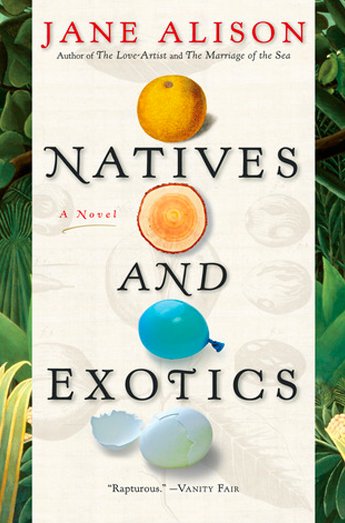 “A tender, lyrical novel…. a lush evocation of the way people love and alter (and are altered by) the environments they inhabit.” — Publishers Weekly (starred review)
“A tender, lyrical novel…. a lush evocation of the way people love and alter (and are altered by) the environments they inhabit.” — Publishers Weekly (starred review)
In the manner of W. G. Sebald’s The Emigrants, Natives and Exotics follows three characters, linked by blood and legacy, as they wander a world scarred by colonialism.
Transplanted halfway around the globe in 1970, nine-year-old Alice, the child of diplomats, is ravished by the beauty of Ecuador, a country her parents are helping to despoil. Forty years earlier, Alice’s newlywed grandmother Violet confronts troubling traces of her country’s past as she makes a home in the wilds of Australia. And before that, in early nineteenth-century Scotland, Violet’s great-great-grandfather George flees the violence of the Clearances for the Portuguese Azores, unaware that he will have a hand in destroying the earthly paradise there.
The third novel by the author of the critically acclaimed The Marriage of the Sea and The Love-Artist, Natives and Exotics is a hypnotic meditation on our passionate, uneasy affair with nature, in which we restlessly search for home.
Reviews
 Publishers Weekly
Publishers Weekly
Generations of an Australian family are linked across time and space by their relationships to a changing world and a common search for a true home in a tender, lyrical novel that explores the consequences of so-called “progress.” Nine-year-old Alice is brought to Ecuador by her mother and U.S. diplomat stepfather. Alison (The Marriage of the Sea) richly, precisely describes how the beautiful landscape entrances Alice, even as the sterile, rootless diplomatic life keeps the heart of her host country du jour at bay. The political unrest of 1970s Ecuador and hostility toward the oil-hungry U.S. further alienate Alice as she struggles to determine where she belongs. The novel’s next section tells how, some 40 years earlier, Alice’s grandmother Violet leaves the comforts of Adelaide for a life with her new husband in the Australian bush. Pregnant with Alice’s mother, Violet struggles to hack tree stumps from the ground as she ponders her own roots: those who came before her to Australia, and the elusive nature of home for those born with wanderlust.
The story of Violet’s great-great-grandfather George is one of a people ravaging a land in the name of “Civilization, [and] the Empire’s advance upon the globe.” More impressionistic than narrative, Alison’s third novel is a lush evocation of the way people love and alter (and are altered by) the environments they inhabit.
 Charlotter Observer
Charlotter Observer
“Botanical misdeeds in exotic locations”
By Tamara Titus – June 3, 2005
In her third novel, “Natives and Exotics,” Jane Alison tackles the themes of colonization, emigration and man’s impact on the natural world.
Alison, who teaches in the MFA program at Queens University of Charlotte, fashions her tale from the lives of three relatives: George, a native of Scotland who emigrates first to the Azores and then to Australia; his great-great-granddaughter, Violet, a woman who longs to travel; and Violet’s granddaughter, Alice, who by the age of 9 has seen “her fourth country, sixth city, seventh house.”
Alice’s stepfather is a U.S. diplomat, and when he accepts a post to Ecuador in the 1970s, Alice is mesmerized by the new country: “The sky was saturated blue, so dense it was unbearable that you couldn’t just clutch it.” The volcanic peak of Mount Pichincha hovers in the background as Alice and her schoolmates–children of oil executives and of diplomats–fall under the spell of the exotic landscape.
The city of Quito teems with beauty and bounty, but it also teems with danger. The water is unsuitable for drinking. Bars cover the windows of Alice’s new house, and she finds broken glass embedded in the high walls around the garden. Soon after she arrives, a coup takes place, resulting in military rule. Cut off from many normal childhood pleasures, Alice takes solace in the natural world. And it isn’t long before she realizes that her stepfather and the men around him are depleting the country of its resources.
Thousands of miles away and 150 years earlier, one of Alice’s ancestors flees his native Scotland. Forced out violently by British soldiers during the 1820s, young George follows Mr. Clarence, the old man who has raised him, to the Clarence family’s citrus plantation in the Portuguese Azores.
Both men are seeking a place apart, a place where the hand of man has not yet left its imprint. Arriving at the island of St. Michael, they find a volcanic paradise. Hot springs and towering plants cover the land. In town, vendors sell fruits such as maracuja, cape strawberry, custard apple and pimentão.
At first, Mr. Clarence seems content with the lush landscape around him. Each day he joins George in the orchard, reading his scientific journals and savoring oranges while George works to rejuvenate the trees. Mr. Clarence turns his seat to follow the progress of the sun, and the day’s end finds him “surrounded by small planetary heaps of peel.”
But soon the old man eats only the side of the orange that has ripened in the sun (a native habit) and from there it is only a small step to his suggestion that the perfect orange might be a hybrid–a cross between a St. Michael’s and a Seville. Reluctantly, George crosses two trees and the men wait for them to bear fruit. But when the newly formed oranges finally ripen, they are hideously deformed and inedible.
And cross-breeding oranges is not their only sin. George and Mr. Clarence also create a private garden, importing plants from all over the world: eucalyptus and banksias from Australia, tree ferns from New Zealand and a monkey puzzle plant from Chile. The exotic newcomers flourish, but a blight takes hold of the orchards, and Mr. Clarence is sure that it is a punishment from God. In reality, it is the result of a parasite–one likely imported along with the nonnative plants.
Alison seamlessly weaves historical facts into her story: the destruction of native species on St. Helena island, the extermination of the Pampas Indians in South America, and the removal of the Aborigines of Tasmania. However, “Natives and Exotics” is not just a litany of man’s misdeeds. When George’s great-great-granddaughter, Violet, travels to the Botanical Gardens at Kew in England, her fellow Australians purchase seeds they hope will grow in their gardens back in Adelaide. Here, Alison illustrates man’s ability to learn from his mistakes. “They won’t let those seeds in at home, you know,” says one of the women. “Won’t let you through immigration.”
“Natives and Exotics” walks a thin line between a novel of ideas and character-driven fiction, but the author’s keen insights keep this book on track. With luxurious prose and well-researched details, Alison stakes a powerful claim to the best socially conscious literature.
 National Public Radio
National Public Radio
“An Armful of Books for the Summer”
By Alan Cheuse – June 13, 2005
[On All Things Considered, book critic Alan Cheuse offers his list of recommended summer reading, including fiction, poetry and short-story collections. He suggests titles from Jane Alison, Arthur C. Clarke, William Carlos Williams and more.]
In a lyrical series of chapters, [Alison] recalls the adventures of a family of wanderers and settlers and diplomats, with an early cameo appearance by the great German naturalist and explorer Alexander Von Humboldt . . . a fascinating summer journey between book covers that spans centuries and continents.
 New Orleans Times-Picayune
New Orleans Times-Picayune
“That’s progress?”
Julia Kamysz Lane – June 3, 2005
In her third novel, “Natives and Exotics,” former New Orleanian Jane Alison thoughtfully explores one of her favorite themes, nature, and how humankind both values and devours it. She also raises provocative questions: When it comes to people, what is natural instinct? Are we intrinsically programmed to destroy the very world we seek to understand? Are we doomed to repeat our mistakes? The novel introduces characters, real and imagined, whose actions speak for themselves, at least from Alison’s perspective. From 18th-century British explorers Captain James Cook and Sir Joseph Banks to fictional 20th-century American diplomat Hal Forder, Alison unapologetically condemns what has long passed for progress. For context and to give a universal undercurrent, Alison dips into the lives of three generations spanning three centuries and multiple continents: Young Alice Forder, Alice’s grandmother Violet, and Violet’s great-great-grandfather George. Alice, her American diplomat stepfather, Hal, and her Australian mother, Rosalind, are settling in at their latest post, Ecuador, in the 1970s. Though still a child, Alice has grown cynical in order to adapt to her ever-changing surroundings; “She was nine, and this would be her fourth country, sixth city, seventh house.” Rosalind is a sensitive soul, homesick for her native country, whereas Hal is heartlessly practical and self-righteous about his role overseeing the United States’ interests, namely Ecuadorian oil. In fact, all of the Americans in “Natives and Exotics” are portrayed as stereotypical money-grubbers without a conscience to counterbalance their capitalist agenda. Alice escapes the adults’ constant feuding by absorbing the exquisite beauty of her surroundings: “. . . the sky lost its light quickly, there on the equator. Then the city lay glittering in the mountain’s lap, its lights mirrored by the stars. It didn’t seem possible, as Alice stood on the balcony and stared up, that there could be so many stars. As if, were you to pull away the veil of black, all that light would fall.” As Part I comes to an unsettling close, with the political tension of Ecuador at its peak, Part II opens by transporting the reader to a seemingly simpler time. Alice’s grandmother, Violet, is a restless newlywed in the Australian bush in 1929. Though pregnant with Rosalind, she is determined to help her husband and the other men dig out tree stumps to clear the land. The physical activity gives her plenty of time to think and she ponders her ancestors, curious about their motives for coming here. Did they choose to come? Or were they criminals shipped off to this new land? Part III , set in 1822 Scotland, answers Violet’s questions, sharing the sad story of her great-great-grandfather, George. George, his friend Mr. Clarence, and their neighbors are fleeing from the English, who are burning down their homes and trees to clear the land for sheep. Thanks to Mr. Clarence’s brother in London, they find refuge at an abandoned orange plantation in the Portuguese Azores. This new home awakens all of George’s senses: “The rustling leaves, the warm green smell, the wrinkled skin of the trunks–these trees seemed to him like life perpetual, as if they had always existed and would live on forever.” This tranquility is short lived, however, as George’s love of nature cannot overrule his urge to experiment with it. All three main characters–George, Violet and Alice–witness, and in some cases, have a hand in man’s brutal zeal to conquer far-off lands and other people in the name of civilization. At times, Alison’s lessons overwhelm the characters. Readers who sympathize with her message will gladly overlook the heavy-handedness; those who disagree with it will probably be less forgiving. However, all will savor the breathtaking imagery and philosophical wanderlust of “Natives and Exotics.”
 The New York Times
The New York Times
“Transplants”
By Sue Halpern – May 15, 2005
Wander into any garden club meeting or sit down with the local conservation commission and it won’t be long before the topic of native versus non-native species appears on the agenda. Sometimes the non-natives are called “exotics”–think of a prickly pear cactus on a New England windowsill. More often, though, the non-natives are called “invasives” or “aliens,” terms that radiate contempt. Who, after all, could favor the zebra mussel, that prolific Caspian mollusk now wreaking havoc from the Gulf of Mexico to Lake Superior? Or purple loosestrife, that magnificent, seductive, agricultural strangler?
Nomenclature aside, the debate is really about boundaries and scale–is the earth a single place or is it any number of discrete places?–and about belonging. In southwestern Scotland, for instance, tropical palm trees, imported from the South Seas, root deep in the soil. They’ve grown there for hundreds of years, yet the question persists: do they belong?
Alice Forder, the youngest member of the family chronicled back through the generations in Jane Alison’s third novel, “Natives and Exotics,” feels a kinship with these unlikely trees. Alice is an exotic herself, a child of the foreign service who has moved around so much that she’s from nowhere in particular, though she keeps a stuffed kangaroo from Australia, the country of her birth. The toy was a gift from her grandmother Violet–another woman of an unsettled nature. As a bride, Violet moved with her husband from Adelaide, where they were teachers, to the Outback, where they became settlers, clearing the land of the vegetation that clings to it so stubbornly.
Violet and her husband go about this with a single-mindedness–call it dominion–that haunts her. “People wandered and wandered, and what did it mean, where on earth did they ever belong?” she wonders as she wrestles a root ball. “They weren’t plants, after all. She felt lunatic. She put her hands to her burning cheeks. What she meant was, if people weren’t plants and didn’t grow from the ground, how could they ever belong anywhere? What was home?” Though that may be an impossible question to answer directly, it seems oddly heritable both for Violet and for Alison, who is drawing here on her own family history.
Violet is, in turn, the descendant of an early Australian settler named George Clarence, a gifted horticulturalist whose harrowing flights, first from Scotland to the Azores and later from there to the Antipodes, follow the violence and blight wrought by people intent on “improving” the land. He plants apples in Scotland and oranges in the islands, but is never able to situate himself. Of his life in Australia, little is known.
As “Natives and Exotics” works its earnest, somewhat overdetermined way from Alice to Violet to George, it becomes more a novel of scenes than of story. There is Alice as a 9-year-old living in Ecuador as that country tries to stand up to the neighborhood bully, the United States. There is Violet, pawing at the untamed ground of the Australian wilderness, which may never yield to her as a home. And there is George, Alison’s most fully imagined character, a mute and a misfit who somehow manages to find his way into the world of people and progeny. Though it’s never clear how this happens–George is still a primitive when he flees the tropics–the result is a kind of family album where, finally, no one is out of place.
 Seattle Times
Seattle Times
“Novelist sees fierce beauty in the natural world”
By Richard Wallace – June 19, 2005
Charles Darwin turns up in Jane Alison’s thoughtful third novel, “Natives and Exotics.” It’s a cameo appearance, but a telling one. Heading back to England on the schooner HMS Beagle, Darwin ruminates on the fate of the giant tortoises of the Galapagos: “He had tried to ride one but couldn’t keep his balance and soon felt foolish astride the grand creature. They could get to be awfully old. He’d seen one with 1786 carved in its shell! They might be old as trees. Yet within twenty years they would all be captured, overturned, scooped out, and eaten; not one would remain. Just as, he suspected, the kangaroos of Australia would soon be gone. Men did what they must do to live, after all.”
This interplay of human wishes on nature’s grand pageant of life is a current that runs through Alison’s narration, linking three generations of a family.
Organized into five parts, the novel tells a trio of stories. The first introduces the Forder family–Hal, Rosalind and 9-year-old Alice. Hal is a career diplomat, just assigned to the U.S. embassy in Quito, Ecuador, in the early 1970s. The political situation is volatile: A new leader has taken control of the country, challenging American interests. While her stepfather works, Alice goes to an exclusive school, learning to make new friends, practicing a new language and marveling in the beauty of the country.
Jane Alison spent her childhood in the foreign service, and her details of this elite, transient life are vivid and poignant: Alice’s initiation into the inner circle of school girls, the grown-up parties mimicked by the children, the rush of new places and sensations, give this section of the book the completeness of a well-crafted novella. Through Alice’s eyes we see the repercussions of lives spent without cultural roots, where every stay is exotic and brief.
Part 2 moves the novel to Australia, 1929. Violet is a young newlywed, homesteading in the wilds. As she tries without success to dig out a tenacious mallee tree stump, Violet daydreams about her conflicting desire to see the world verses the rural life she has chosen for herself: “… People wandered and wandered, and what did it mean, where on earth did they ever belong? They weren’t plants, after all.”
Part 3 takes the story to the historical roots of Violet’s past, early 19th-century Scotland. Her great-great-grandfather, a mute young man named George, and his protector Mr. Clarence escape the violent land grabs known as the Clearances. They begin a new life as orange farmers in the Portuguese Azores, islands in the North Atlantic Ocean. While the sedentary Mr. Clarence philosophizes about the colonial march of progress, George passionately cultivates a garden sanctuary away from human affairs. Soon the political fortunes of Portugal and a tree blight infestation turn this adventure into an ecological failure. George leaves the Azores for Australia.
The final two sections pick up Violet and Alice’s story. Violet, now elderly, takes a global cruise, only to become increasingly homesick. And Alice, now a young woman, brings the family’s story full circle, as she explores a Scottish beach.
Unlike her highly successful debut novel “The Love-Artist,” “Natives and Exotics” has no strong dramatic pull. Each story is a meditation. As such, many characters have a static quality, designed for Alison’s musings about foreign and native, which aren’t particularly enlightening.
What gives pleasure is how precisely she sees the fierce beauty of the natural world, as it moves, grows, evolves, both despite and because of the blind interference of humankind.
 Washington Post
Washington Post
“The truth will out in tales of family turmoil”
By Andrew Ervin – June 12, 2005
In Natives and Exotics, Jane Alison takes us where history books can’t–or won’t–go. A string of novella-like chapters transports us further and further into the past to form revelatory connections among global imperialism, scientific discovery and environmental destruction.
After a brief prologue set in the 19th century, Alison moves to those halcyon, Nixon-era days. A young woman’s parents drag her to live among Ecuador’s expatriate community of oil barons seeking to prosper from the nation’s political unrest. Alice’s bourgeois upbringing acts as a kind of looking glass through which she witnesses previously unimaginable levels of poverty and idyllic, natural beauty–the very beauty her father’s cronies are threatening.
In another section, set during the 1920s in the Australian wilderness, Alice’s grandmother Violet struggles to make a rough plot of ground suitable for human use. Doing so means uprooting the native species. Elsewhere, in 1822, the locals are expelled as a different tract of land is “cleared for betterment, for sheep.” Colonialism and displacement become major themes, and they resound loudly through this multigenerational saga. Though set hundreds of years apart, these stories quickly flow into a single narrative powerful enough to show how closely related our familial, political and natural worlds really are.